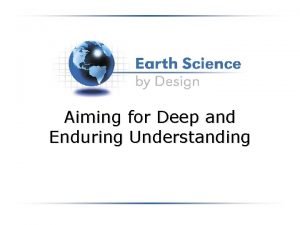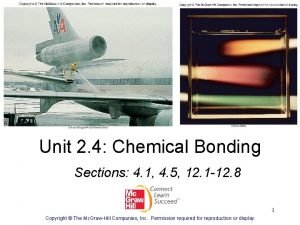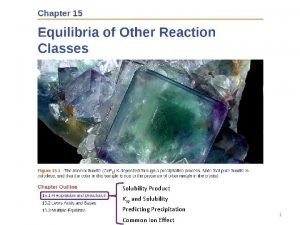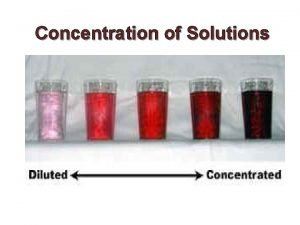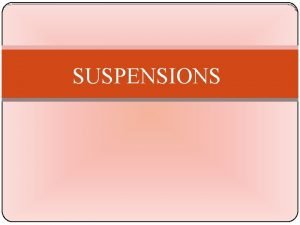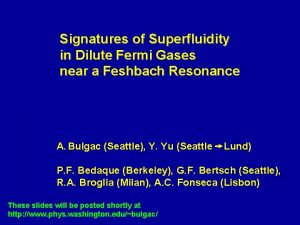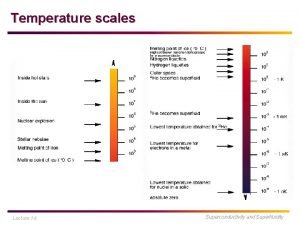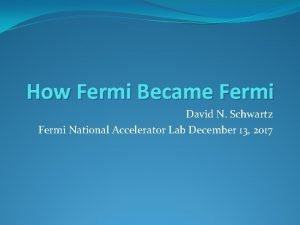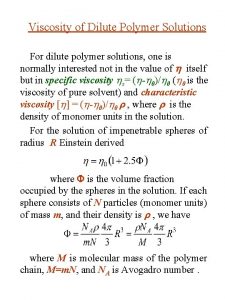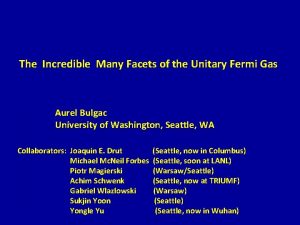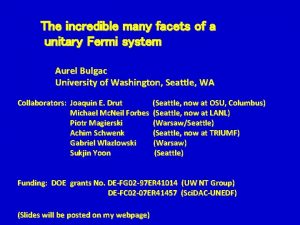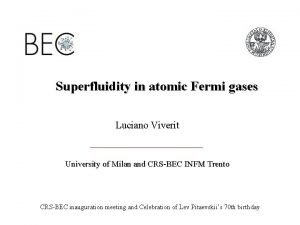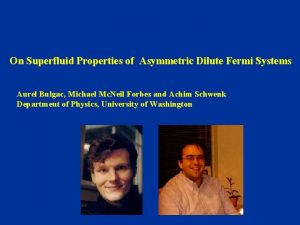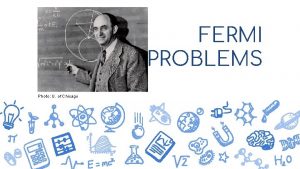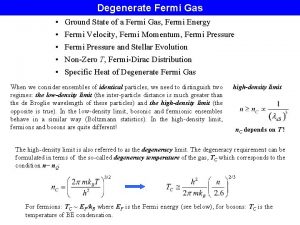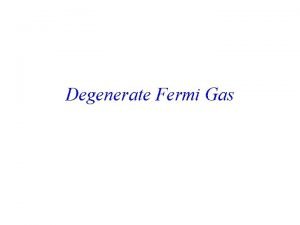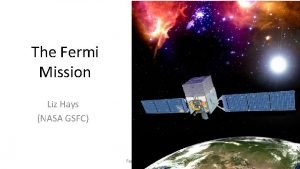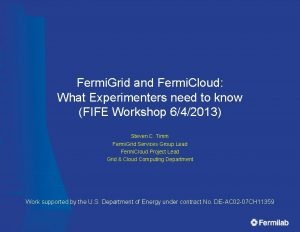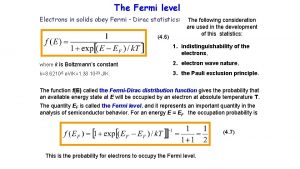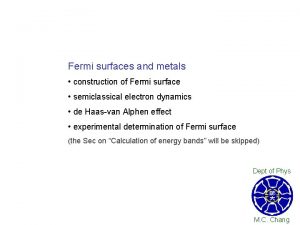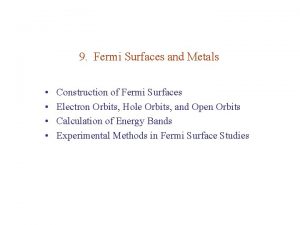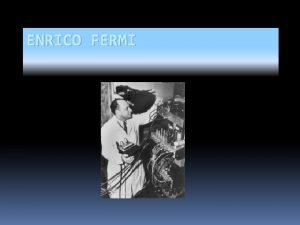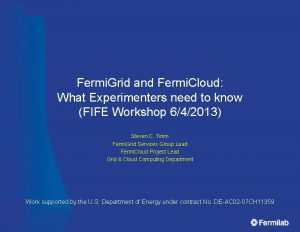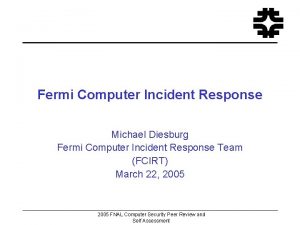The Many Facets of Superfluidity in Dilute Fermi
















































- Slides: 48

The Many Facets of Superfluidity in Dilute Fermi Systems collaborators: Yongle Yu, P. F. Bedaque. A. C. Fonseca Transparencies will be available shortly at http: //www. phys. washington. edu/~bulgac

Robert B. Laughlin, Nobel Lecture, December 8, 1998

Superconductivity and superfluidity in Fermi syste ü Dilute atomic Fermi gases Tc > 10 -12 e. V • Liquid 3 He Tc > 10 -7 e. V • Metals, composite materials e. V Tc > 10 -3 – 10 -2 • Nuclei, neutron stars e. V Tc > 105 – 106 • QCD color superconductivity e. V Tc > 107 – 108 units (1 e. V > 104 K)

Memorable years in the history of superfluidity and superconductivity of Fermi systems • 1913 Kamerlingh Onnes • 1972 Bardeen, Cooper and Schrieffer • 1973 Esaki, Giaever and Josephson • 1987 Bednorz and Muller • 1996 Lee, Osheroff and Richardson • 2003 Abrikosov, Ginzburg and Leggett

How pairing emerges? Cooper’s argument (1956) Gap 2 D Cooper pair

In dilute Fermi systems only very few characteristics are relevant. • These systems are typically very cold • A dilute Fermi system is degenerate and the fastest particle has a momentum of the order of the Fermi momentum • The wave functions are basically constant over the interaction volume of two particles and thus they cannot “see” any details, except the scattering length typically.

What is the scattering length? In the region outside the potential well At very low energies the interaction of two particles can be approximated by the “potential”

In dilute atomic systems experimenters can control nowadays almost anything: • The number of atoms in the trap • The density of atoms • Mixtures of various atoms • The temperature of the atomic cloud • The strength of the atom-atom interaction

HISTORY ü 1995 BEC was observed. ü 2000 vortices in BEC were created thus BEC confirmed un-ambiguously. ü In 1999 De. Marco and Jin created a degenerate atomic Fermi gas. ü 2002 O’Hara, Hammer, Gehm, Granada and Thomas observed expansion of a Fermi cloud compatible with the existence of a superfluid fermionic phase. ü 2003 Jin’s, Grimm’s, Ketterle’s groups and others ultracold molecules, m. BEC from Fermi gas ü 2004 Jin’s group announces the observation of the resonance condensation of fermionic atomic pairs ?

Feshbach resonance Tiesinga, Verhaar, Stoof Phys. Rev. A 47, 4114 (1993) Regal and Jin Phys. Rev. Lett. 90, 230404 (2003)

BCS →BEC crossover Leggett (1980), Nozieres and Schmitt-Rink (1985), Randeria et al. (1993) If a<0 at T=0 a Fermi system is a BCS superfluid If |a|=∞ and nr 03 1 a Fermi system is strongly coupled and its properties are universal. Carlson et al. PRL 91, 050401 (2003) If a>0 (a≫r 0) and na 3 1 the system is a dilute BEC of tightly bound dimers

Expected phases of a two species dilute Fermi system T High T, normal atomic (plus a few molecules) phase BCS Superfluid a<0 no 2 -body bound state ? Molecular BEC and Atomic+Molecular Superfluids 1/a a>0 shallow 2 -body bound state

Regal, Ticknor, Bohm and Jin, Nature 424, 47 (2003) Number of atoms after ramping B from 228. 25 G to 216. 15 (black dots) and for ramping B down (at 40 ms/G) and up at various rates (squares). a) Loss of atoms |9/2, -9/2> and |9/2, -5/2> as a function of final B. The initial value of b) B=227. 81 G. c) b) Scattering length between hyperfine states |9/2, -9/2> and |9/2, -5/2> as a function d) of the magnetic field B.

Regal, Ticknor, Bohm and Jin, Nature 424, 47 (2003) Symmetric peak is near the atomic |9/2, -5/2> to |9/2, -7/2> transition. The total number of |9/2, -5/2> and |9/2, -7/2> atoms is constant. Asymmetric peak corresponds to dissociation of molecules into free |9/2, -5/2> and |9/2, -7/2> atoms. The total number of |9/2, -5/2> and |9/2, -7/2> atoms increases. Dimer/molecule binding energy

Molecular BEC in a cloud of 40 K atoms (fermions) Greiner, Regal and Jin, Nature 426, 537 (2003) T > TC T<TC

Size of the atomic cloud as a function of temperature around the critical temperature

Grimm’s group cond-mat/04010109

Grimm’s group, cond-mat/04010109



a>0 a<0

a>0 a<0 ? |k. Fa|>1 BEC side BCS side


What did they see in this last experiment? Did they put in evidence a BCS-like superfluid? What was the order parameter? Assuming that they’ve determined correctly Tc for |a|= one would get Tc ≈0. 3Δ NB Tc is unknown both theoretically and experimentally in the strong coupling limit.

Köhler, Gasenzer, Jullienne and Burnett PRL 91, 230401 (2003). NB The size of the “Feshbach molecule” (closed channel state) is largely B-independent and smaller than the interparticle separation.

We need a well defined procedure for constructing an “effective” Hamiltonian for interacting atoms and dimers starting from the “fundamental” Hamiltonian describing bare interacting atoms. Ham is determined by matching.

Ha Ham E/V atom-atom vertex (Lippmann-Schwinger eq. ) atom-dimer vertex (Faddeev eqs. ) dimer-dimer vertex (Yakubovsky eqs. ) Matching between the 2 --, 3 -- and 4 --particle amplitudes computed with Ha and Ham. Only diagrams containing l 2 --vertices are shown. The effective vertices thus defined (right side) can then be used to compute the ground state interaction energy in the leading order terms in an na 3 expansion, which is given by the diagrams after the arrows.

Fermi atoms aam was first computed first by Skornyakov and Ter-Martirosian (1957) who studied neutron-deuteron scattering. amm was computed by Petrov (2003) and Fonseca (2003).

Consider now a dilute mixture of fermionic atoms and (bosonic) dimers at temperatures smaller than the dimer binding energy (a>0 and a≫r 0) Even though atoms repel there is BCS pairing! One can show that pairing is typically weak in dilute systems! Induced fermion-fermion interaction Bardeen et al. (1967), Heiselberg et al. (2000), Bijlsma et al. (2000) Viverit (2000), Viverit and Giorgini (2000) coherence/healing length and speed of sound

The atom-dimer mixture can potentially be a system where relatively strong coupling pairing can occur. nb a 3 = 0. 064 (solid line) nb a 3 = 0. 037 (dashed line) p-wave pairing (dots)

How this atomic-molecular cloud really looks like in a trap? Core: Molecular BEC Crust: Crust normal Fermi fluid Mantle: Mantle Molecular BEC + Atomic Fermi Superfluid Everything s made of one kind of atoms only, in two different hyperfine states.

All this follows by solving the Thomas-Fermi equations: The mantle, the layer between the core and the crust. Molecular BEC + Fermi BCS The crust, the outside layer. Normal Fermi gas The core, the central region. Molecular BEC

What happens when |a|= ?

Consider Bertsch’s MBX challenge (1999): “Find the ground state of infinite homogeneous neutron matter interacting with an infinite scattering length. ” Ø Carlson, Morales, Pandharipande and Ravenhall, PRC 68, 025802 (2003), with Green Function Monte Carlo (GFMC) normal state Ø Carlson, Chang, Pandharipande and Schmidt, PRL 91, 050401 (2003), with GFMC superfluid state This state is half the way from BCS→BEC crossover, the pairing correlations are in the strong coupling limit and HFB invalid again.

Green Function Monte Carlo with Fixed Nodes J. Carlson, S. -Y. Chang, V. Pandharipande and K. Schmidt private communication (2003)

Fixed node GFMC results, J. Carlson et al. (2003)

Even though two atoms can bind, there is no binding among dimers! Fixed node GFMC results, J. Carlson et al. (2003)

BEC Vortices K. W. Madison et al, J. Mod. Opt. 47, 2715 (2000), F. Chevy et al, Phys. Rev. Lett. 85, 2223 (2000). J. R. Abo-Shaeer et al, Science, 285, 1703 (2001)

From Ketterle’s group for bosons (2001) Why would one study vortices in neutral Fermi superfluids? They are perhaps just about the only phenomenon in which one can have a true stable superflow! Observation of stable/quantized vortices in Fermi systems would provide the ultimate and most spectacular proof for the existence of a Fermionic superfluid phase.

Landau criterion for superflow stability (flow without dissipation) Consider a superfluid flowing in a pipe with velocity vs: no internal excitations One single quasi-particle excitation with momentum p In the case of a Fermi superfluid this condition becomes

Density Functional Theory (DFT) Hohenberg and Kohn, 1964 particle density Local Density Approximation (LDA) Kohn and Sham, 1965 The energy density is typically determined in ab initio calculations of infinite homogeneous matter. Normal Fermi systems onl

BCS wave function in infinite systems SLDA for superfluid fermi systems (AB and Y. Yu, 2003) Mean-field and pairing field are both local fields!

The SLDA (renormalized) equations Position and momentum dependent running coupling constant

Vortex in fermion matter

How can one put in evidence a vortex in a Fermi superfluid? Hard to see, since density changes are not expected, unlike the case of a Bose superfluid. However, if the gap is not small, one can expect a noticeable density depletion along the vortex core, and the bigger the gap the bigger the depletion, due to an extremely fast vortical motion. NB Tc unknown in the strong coupling limit!

Now one can construct an LDA functional to describe this new state of Fermionic matter Ø This form is not unique, as one can have either: b=0 (set I) or b≠ 0 and m*=m (set II). Ø Gradient terms not determined yet (expected minor role).

Solid lines - parameter set I, Dashed lines for parameter set II Dots – velocity profile for ideal vortex The depletion along the vortex core is reminiscent of the corresponding density depletion in the case of a vortex in a Bose superfluid, when the density vanishes exactly along the axis for 100% BEC. Extremely fast quantum vortical motion!

Conclusions: ü The field of dilute atomic systems is going to be for many years to come one of the most exciting fields in physics, with lots surprises at every corner.
 6 facets of understanding
6 facets of understanding 6 facets of learning
6 facets of learning Five factor model facets
Five factor model facets Miller-orr model ppt
Miller-orr model ppt Facets of curriculum
Facets of curriculum Wi facets
Wi facets Facets of formative assessment
Facets of formative assessment Facets of culture
Facets of culture Facets model of effects advertising
Facets model of effects advertising Dilute solution definition
Dilute solution definition Concentration and strength
Concentration and strength Chapter 4 reactions in aqueous solutions
Chapter 4 reactions in aqueous solutions Common ion solubility
Common ion solubility Concentrated solution
Concentrated solution Oxidation desizing agent
Oxidation desizing agent Solute
Solute Suspensions advantages and disadvantages
Suspensions advantages and disadvantages Cái miệng xinh xinh thế chỉ nói điều hay thôi
Cái miệng xinh xinh thế chỉ nói điều hay thôi Các châu lục và đại dương trên thế giới
Các châu lục và đại dương trên thế giới Từ ngữ thể hiện lòng nhân hậu
Từ ngữ thể hiện lòng nhân hậu Bổ thể
Bổ thể Tư thế ngồi viết
Tư thế ngồi viết V. c c
V. c c Thơ thất ngôn tứ tuyệt đường luật
Thơ thất ngôn tứ tuyệt đường luật Hát lên người ơi
Hát lên người ơi Khi nào hổ con có thể sống độc lập
Khi nào hổ con có thể sống độc lập đại từ thay thế
đại từ thay thế Diễn thế sinh thái là
Diễn thế sinh thái là Vẽ hình chiếu vuông góc của vật thể sau
Vẽ hình chiếu vuông góc của vật thể sau Công thức tiính động năng
Công thức tiính động năng Phép trừ bù
Phép trừ bù Tỉ lệ cơ thể trẻ em
Tỉ lệ cơ thể trẻ em Thế nào là mạng điện lắp đặt kiểu nổi
Thế nào là mạng điện lắp đặt kiểu nổi Lời thề hippocrates
Lời thề hippocrates Vẽ hình chiếu đứng bằng cạnh của vật thể
Vẽ hình chiếu đứng bằng cạnh của vật thể Quá trình desamine hóa có thể tạo ra
Quá trình desamine hóa có thể tạo ra Môn thể thao bắt đầu bằng từ đua
Môn thể thao bắt đầu bằng từ đua Hình ảnh bộ gõ cơ thể búng tay
Hình ảnh bộ gõ cơ thể búng tay Sự nuôi và dạy con của hổ
Sự nuôi và dạy con của hổ Các loại đột biến cấu trúc nhiễm sắc thể
Các loại đột biến cấu trúc nhiễm sắc thể Nguyên nhân của sự mỏi cơ sinh 8
Nguyên nhân của sự mỏi cơ sinh 8 Trời xanh đây là của chúng ta thể thơ
Trời xanh đây là của chúng ta thể thơ độ dài liên kết
độ dài liên kết Voi kéo gỗ như thế nào
Voi kéo gỗ như thế nào Thiếu nhi thế giới liên hoan
Thiếu nhi thế giới liên hoan Vẽ hình chiếu vuông góc của vật thể sau
Vẽ hình chiếu vuông góc của vật thể sau điện thế nghỉ
điện thế nghỉ Một số thể thơ truyền thống
Một số thể thơ truyền thống Thế nào là hệ số cao nhất
Thế nào là hệ số cao nhất
